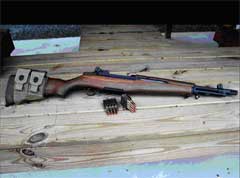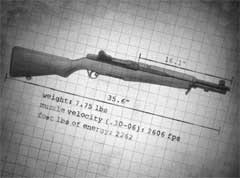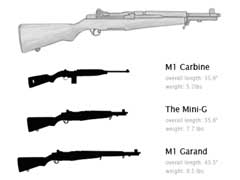|
Click pictures for a larger version.


|
|
[Ed. Note: Scott Longman is an author,
shooter, and thoroughly interesting gentleman. Scott came to be
my friend while I was in the process of reviewing his excellent
book, "Facing
the Charge: African Dangerous Game" (available online from
Sporting Classics Store), written with experienced African
hunter Michael J. Miller. I
posted a video review of the book on YouTube last Summer
(check out some of the comments - sadly entertaining); I have
re-read the book several times, and give it my highest
recommendation. Scott is a truly nice guy and a fine writer,
whose entertaining writing style engages the reader as few
modern writers' do. I am pleased that he offered Gunblast this
article for publication. - Boge
Quinn]
When an ol’ boy
like General George S. Patton proclaims a rifle to be “the
greatest battle implement ever devised,” that’s the gold
standard. He
was, of course, speaking of the M-1 Garand. In the decades since George ate Adolph’s lunch, there’s
been a trend in military rifle cartridges toward “smaller,
lighter and a lot more of them.”
But a great many respected people still believe that, for
many applications, a well-placed railroad spike beats a whole
box of staples. Tim
Shufflin is one of them.
Tim, or “Shuff,”
owns Shuff’s
Parkerizing, which really ought to be called “Shuff’s
Complete and Brilliantly Inventive Gunsmithing Service.”
In that role, Tim has done just about everything that
there is to be done to a Garand:
he’s built National Match, M-1C’s, M-1D’s,
detachable-box magazine versions, .308 conversions, BM-59 gas
tube swaps and a great deal more.
In short, he knows his way around John Garand’s
masterpiece.
For all of the
M-1’s virtues, one thing it isn’t is light.
And another thing it isn’t is short:
an empty Garand without a sling, scope or bayonet tips in
at 9.5 pounds, and is longer than a European vacation with your
mother-in-law. And
while the original rifle is remarkably well-balanced for its
size, running a Google search on the words “Garand and
handy” will net you zero results.
Which got Shuff thinking.
There was a shortened version of the Lee Enfield.
There was a shortened version of the Mauser. More recently, we insist on calling shortened M-16s the M-4.
Couldn’t we do the same thing with the venerable old
Nazi-smasher? It’s
true that it had been tried before, with the “tanker”
versions, but that didn’t work out all that well, for two
reasons. First,
they weren’t that much shorter or than the original, and
second, at least some of them had reliability issues.
Shuff set out to change that, with two key goals in mind:
a 16-inch barrel and utter reliability.
At first thought,
those goals don’t sound like they should be all that
difficult, but they are. While
it is easy to forget now that we live in a world with
gas-operated rifles under every couch cushion, building the
first reliable ones was a mammoth undertaking.
The road to the Garand had more abandoned relics on it
than an ISIS column after the A-10s have visited.
General Julian Hatcher of firearms legend was present for
parts of the development of the Garand, and he chronicled the
also-rans, their designs, their failures in two excellent
volumes known as “Hatcher’s
Book of the Garand” and “Hatcher’s
Notebook” (available on Amazon - search links provided). And indeed, Garand himself created some of the also-rans:
his successful design was his third major effort, and
even after he came up with that, its gas system had to be
changed from the original “gas trap” to what we now think of
as a conventional piston. The
magic combination of weight and inertia and gas volume and
metallurgy and heat dissipation and angles and camming surfaces
and spring force was nearly as complex and mysterious as the
first multi-celled life form.
But because John Garand was a genius, he ultimately got
it all exactly right. A
change to any part of that mechanical ecosystem generally gets
you a dead Garand. But
Shuff figured out how to change the system and have the rifle
not only live, but thrive.
So what did he end up
with? You get the
magnificent power, range and penetration of the .30-06 in a
package you could nearly pop into your lunchbox:
it weighs in at 7.7 pounds, and is the same miniscule
overall length as its unrelated but similarly-named colleague,
the M-1 carbine. Shuff
christened it “the Mini-G.”
To hold one for the first time, the immediate impression
is that you have a Garand with a box of anti-gravity in place of
a flash-hider. It
shoulders beautifully, and points with a swiftness that requires
a reprogramming of your brain.
But wonderful
handling doesn’t matter if a rifle doesn’t shoot, so we
rolled off to the range. Part
of Shuff’s service is to function-check every weapon he works
on, and to make it run perfectly.
Which we witnessed for ourselves as soon as we hit the
range: the action
flowed like a trout stream, smoothly accepting the en-bloc clips
and locking into battery with that marvelous mechanical slam of
the Garand. We
fired nearly 200 rounds of several different types, all with
perfect feed, extraction and ejection.
We’d wondered:
would the conversion hurt accuracy?
There is nothing about a barrel being shorter that, by
itself, necessarily hurts accuracy. But a shorter barrel does mean a shorter sight radius, with
the potential to reduce accuracy.
And more importantly, each barrel has its own harmonics,
which means that, for a given weapon, with a given load, with
given contact with receiver and forend, there will be some
barrel lengths which respond better under the harmonics of
firing, and others that respond worse.
If the shortening hits a bad bunch of harmonics, it can
be much worse.
So what happened
here? It was plenty
accurate. Firing at
100 yards from sandbags, with the iron sights, we got the
following results. With cheap, ancient surplus 150 grain rounds, the Mini-G
turned in groups just under four inches. Using
new 165 grain rounds closed that by a half an inch. As usual, you have to consider that it was only us on the
trigger. Put a
modern-day Chris Kyle on it, and no doubt those groups would
look like they’d jumped in cold water.
Of course, then there
are optics. One of
the criticisms of the original design was that it didn’t allow
for conventional optics mounting, on top of the receiver,
because you have to have access to load the en-bloc clips.
At the time, the Ordnance Department experimented with an
oddball prismatic scope offset to one side but with the eyepiece
in the usual place. Finally,
they said the hell with it and simply mounted a regular scope
off to the side, which then caused all kinds of other problems.
Shuff has the modern solution:
he mounts an Ultimak scout rail just forward of the
receiver. That
position works with holographic, reflex and conventional
long-eye-relief optics. We
put on an EOTECH, with zero magnification, and found that the
rifle shot about the same as with the iron sights.
What about muzzle blast?
When the Brits first cut down the .303 Enfield, the
resultant fireball would have cleared half of Borneo.
Likewise, the shorty-16 experiment known as the XM-177
couldn’t make up its mind if it was a carbine or a
flamethrower, which explains why it immediately grew a flash hider
the size of a tube of Crest.
Well, all the same chemistry applies here, for all the
same reasons: the shorter tube means less length and time in which to
combust all that beautiful IMR powder.
But the powder, having usually spent years waiting for
this moment, isn’t about to bow out gracefully.
Instead, it simply goes all exothermic outside the
barrel. And yes,
the effect is very much present in the Mini-G. The gun roars out incandescent watermelons that are audible
clear to Terra Haute and visible past Peoria.
Whether that matters or not depends on what you are using
it for. If you are
bagging whitetail, or dropping a charging grizzly, there’s no
problem. Likewise,
if you are a doorkicker cleaning out an Al-Qaeda studio
apartment, the downside, except for your hearing, is minimal. But if you are in a good healthy rifle fight at night in the
hundred-acre wood, that fireball signature would do bad things
to your life insurance premiums.
Shuff says he has a fix in the form of new flash hider,
but we were not able to test it.
Our
overall eval? Quick, handy, reliable, powerful, accurate enough and, most
importantly, a Garand. Highly
recommended.
Scott
Longman
  
Got something to say about this article?
Want to agree (or disagree) with it? Click the following link to
go to the GUNBlast Feedback Page.
|
|
Click pictures for a larger version.

Mini-G Stats:
Overall Length: 35.6"
Barrel Length: 16.1"
Weight in LBS: 7.7
|
![]()